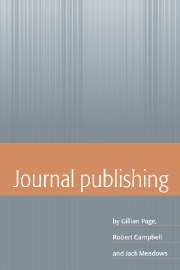Book contents
- Frontmatter
- Contents
- List of figures
- List of tables
- Preface
- 1 Introduction to journals
- 2 Editing
- 3 Production
- 4 Marketing
- 5 Subscription management and distribution
- 6 Non-subscription revenue
- 7 Legal and ethical aspects
- 8 Financial aspects
- 9 Bibliographic aspects
- 10 Managing a list of journals
- 11 Electronic publishing
- Appendix 1 Getting tenders for journals
- Appendix 2 Publishers' and editors' associations
- Glossary
- Bibliography
- Index
8 - Financial aspects
Published online by Cambridge University Press: 23 October 2009
- Frontmatter
- Contents
- List of figures
- List of tables
- Preface
- 1 Introduction to journals
- 2 Editing
- 3 Production
- 4 Marketing
- 5 Subscription management and distribution
- 6 Non-subscription revenue
- 7 Legal and ethical aspects
- 8 Financial aspects
- 9 Bibliographic aspects
- 10 Managing a list of journals
- 11 Electronic publishing
- Appendix 1 Getting tenders for journals
- Appendix 2 Publishers' and editors' associations
- Glossary
- Bibliography
- Index
Summary
Introduction
A journal may be brilliantly edited, beautifully produced, with a large subscription list, and yet be a drain on the resources of the publisher. If a journal, or a list of journals, is to survive financially, the income must be greater than the expenses. There is no way of ensuring that, but disaster is less likely if proper costings are done before prices are fixed; if the figures are monitored regularly; and action taken when actual figures differ from the budget, particularly if they are worse than forecast. This chapter is primarily concerned with journal subscriptions: policy and pricing for other sales are covered in chapter 6.
Some terms and definitions
This section is a beginner's guide to some of the terms commonly used in discussions of journal finances. More experienced readers may wish to skip to the next section. Estes’ Dictionary of Accounting is a useful reference for accounting terms.
It should be noted that different businesses, even in the same sector, do not always treat the same items in the same way. Comparisons of the figures for two publishers, or two journals, are meaningless unless they follow the same practice both for accounting and for the running of the business. For instance, low overhead costs or high ‘sales per employee’ may reflect efficiency; but they could also be the result of sub-contracting all editing, production and subscription fulfilment. A publisher who buys paper ahead of requirements may have a lower bill for materials, but will have the cost of financing it.
- Type
- Chapter
- Information
- Journal Publishing , pp. 270 - 300Publisher: Cambridge University PressPrint publication year: 1997
- 1
- Cited by



